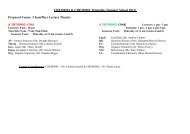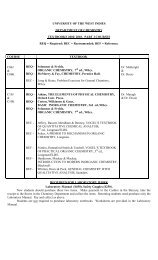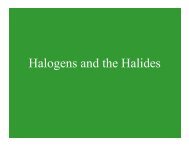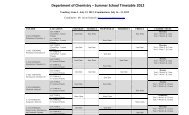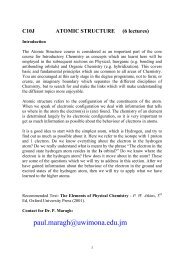Expt. 11: Determination of Available Iodide by Andrew's Titration.
Expt. 11: Determination of Available Iodide by Andrew's Titration.
Expt. 11: Determination of Available Iodide by Andrew's Titration.
Create successful ePaper yourself
Turn your PDF publications into a flip-book with our unique Google optimized e-Paper software.
UNIVERSITY OF THE WEST INDIES<br />
DEPARTMENT OF CHEMISTRY<br />
C10J LABORATORY WORKSHEET<br />
Name: _____________________ Lab. Day: _______________<br />
ID#: _____________________ Date: ____/____/______<br />
<strong>Expt</strong>. <strong>11</strong>: <strong>Determination</strong> <strong>of</strong> <strong>Available</strong> <strong>Iodide</strong> <strong>by</strong> Andrew’s <strong>Titration</strong>.<br />
Caution!!! HANDLE CONCENTRATED HYDROCHLORIC ACID IN THE FUMEHOOD.<br />
i) Volume <strong>of</strong> solution ‘I’ used = _________ cm 3<br />
ii) Concentration <strong>of</strong> solution ‘I’ from previous week = ____________ mol dm -3 .<br />
<strong>Titration</strong> # 1 2 Blank<br />
Final vol. <strong>of</strong> Iodate /cm 3<br />
Initial vol. <strong>of</strong> Iodate /cm 3 Avg.vol/cm 3<br />
Volume <strong>of</strong> Iodate used /cm 3 (3)<br />
Accuracy: 8 + 8 (16)<br />
iii) Observations. – Describe the colour changes observed throughout the titration and explain them<br />
with the aid <strong>of</strong> equations. Give, also, the overall equation <strong>of</strong> the reaction.<br />
…………………………………………………………………………………………………<br />
…………………………………………………………………………………………………<br />
…………………………………………………………………………………………………<br />
…………………………………………………………………………………………………<br />
…………………………………………………………………………………………………<br />
…………………………………………………………………………………………………<br />
…………………………………………………………………………………………………<br />
…………………………………………………………………………………………………<br />
…………………………………………………………………………………………………<br />
…………………………………………………………………………………………………<br />
…………………………………………………………………………………………………<br />
………………………………………………………………………………………………(5)<br />
iv) Calculate the no.<strong>of</strong> moles <strong>of</strong> IO - 3 .used in the titration<br />
…………………………………………………………………………………………………<br />
…………………………………………………………………………………………………<br />
…………………………………………………………………………………………………<br />
…………………………………………………………………………………………………<br />
………………………………………………………………………………………………(3)<br />
v) Calculate the no. <strong>of</strong> moles <strong>of</strong> iodide in the pipetted volume <strong>of</strong> solution ‘I’.<br />
…………………………………………………………………………………………………<br />
…………………………………………………………………………………………………<br />
…………………………………………………………………………………………………<br />
…………………………………………………………………………………………………<br />
………………………………………………………………………………………………(3)
vi) Calculate the concentration (in mol dm -3 ) <strong>of</strong> iodide in solution ‘I’.<br />
…………………………………………………………………………………………………<br />
…………………………………………………………………………………………………<br />
…………………………………………………………………………………………………<br />
…………………………………………………………………………………………………<br />
………………………………………………………………………………………………(3)<br />
vii) Calculate the concentration (in g dm -3 ) <strong>of</strong> iodide in solution ‘I’.<br />
…………………………………………………………………………………………………<br />
…………………………………………………………………………………………………<br />
…………………………………………………………………………………………………<br />
…………………………………………………………………………………………………<br />
………………………………………………………………………………………………(2)<br />
viii) 0.1466 g <strong>of</strong> an iodide sample, MI (group 1 or <strong>11</strong>), was dissolved in 25 cm 3 <strong>of</strong> conc. HCl in a<br />
reagent bottle containing 5 cm 3 <strong>of</strong> CCl 4 . This required 23.36 cm 3 <strong>of</strong> a 0.0189 M KIO 3 solution<br />
to completely decolourize the organic layer. Calculate the percentage iodide in the sample and<br />
hence determine the identity <strong>of</strong> the metal, M.<br />
…………………………………………………………………………………………………<br />
…………………………………………………………………………………………………<br />
…………………………………………………………………………………………………<br />
…………………………………………………………………………………………………<br />
…………………………………………………………………………………………………<br />
…………………………………………………………………………………………………<br />
…………………………………………………………………………………………………<br />
…………………………………………………………………………………………………<br />
…………………………………………………………………………………………………<br />
…………………………………………………………………………………………………<br />
…………………………………………………………………………………………………<br />
…………………………………………………………………………………………………<br />
…………………………………………………………………………………………………<br />
…………………………………………………………………………………………………<br />
…………………………………………………………………………………………………<br />
…………………………………………………………………………………………………<br />
…………………………………………………………………………………………………<br />
…………………………………………………………………………………………………<br />
…………………………………………………………………………………………………<br />
…………………………………………………………………………………………………<br />
…………………………………………………………………………………………………<br />
…………………………………………………………………………………………………<br />
…………………………………………………………………………………………………<br />
…………………………………………………………………………………………………<br />
…………………………………………………………………………………………………<br />
…………………………………………………………………………………………………<br />
…………………………………………………………………………………………………<br />
…………………………………………………………………………………………………<br />
………………………………………………………………………………………………(5)
(ix) Calculate the uncertainty in the value <strong>of</strong> the iodide concentration.<br />
…………………………………………………………………………………………………<br />
…………………………………………………………………………………………………<br />
…………………………………………………………………………………………………<br />
…………………………………………………………………………………………………<br />
…………………………………………………………………………………………………<br />
…………………………………………………………………………………………………<br />
…………………………………………………………………………………………………<br />
…………………………………………………………………………………………………<br />
…………………………………………………………………………………………………<br />
…………………………………………………………………………………………………<br />
…………………………………………………………………………………………………<br />
…………………………………………………………………………………………………<br />
…………………………………………………………………………………………………<br />
…………………………………………………………………………………………………<br />
…………………………………………………………………………………………………<br />
…………………………………………………………………………………………………<br />
…………………………………………………………………………………………………<br />
………………………………………………………………………………………………(6)<br />
(x)<br />
Draw the Lewis structure <strong>of</strong> the tri-iodide ion and predict its geometry.<br />
Geometry is ……………………………….. (3+1)<br />
Pre-laboratory exercise (10)<br />
PTM





